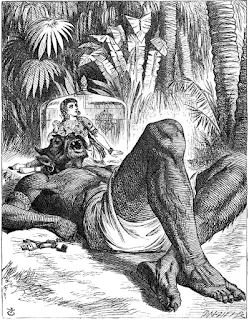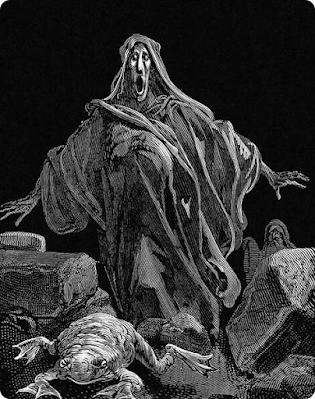
|
|
Scale: 10 ft. Click HERE for a PDF version of this adventure! |
Suitable for 2nd level characters.
A - The Ledge
A1 - Thirsting Effigy
Above a deep defile, a narrow road winds along the mountainside. Flanking the road are steep edges, stone and scree, with the occasional dead or dormant vine: sinking its roots into barren earth. Nestled in the cliff face is a shallow cave - planted in which is a carved statue of a giant fanged bat. Beneath the bat, on the ground - having been cast aside - is a stone bowl. If blood is spilled into the bowl and lifted to the mouth of the statue, the blood will drain, the statue's eyes will flash, and all characters within 20 feet of the statue are transported into B1, by the hanging statue in the south corner.
Two Lizard Men (B38), traveling, have taken refuge in the alcove and are resting.
A2 - Secret Entrance
Dead shrubs cling to the walls of the ravine; anchoring scree and soil. Beneath a thicket here marked is a suspiciously solid slab of stone hidden behind a set of bushes, the stem of which is at its head. The vine is artificial - and if the stem is turned counter-clockwise and then shifted left, it will allow the slab to slide downward into a hidden compartment, opening the secret door.
B - Atrium
B1 - Grand Hall
In the south-east corner, a statue of a bat - identical to the one in A1 - hangs upside down from the ceiling. Characters able to "feed" the bat in the same manner of the statue in A1 will be teleported back to A1. Hanging north-west of the statue, closer to the center of the hall, are three live Giant Bats (B31).
B2 - The Cage
Behind a barred section is a large statue of a bat. Its face has been damaged, one fang is broken and missing, along with half of its face and part of one wing.
B3 - South Entry
An orb sits on a pedestal, half visible, in the center of the room, a slight glow emitting from underneath as though it sits in a concave bowl. If it is turned, the glow increases - and if it is turned quickly, it emits a bright flash. All characters exposed to the flash must Save or be blinded for 1d4 hours.
B4 - North Entry
A faint smell of guano infuses this room. To the north, a hole appears to have been smashed through the wall - leading to B6. The occupants of B6 may notice if a party enters B4 prior to encountering them otherwise.
B5 - Temple
In the center of this room, an eight pointed star is embossed into the floor -
forming small rivulets in the floor. The ceiling is taller than in other
corridors and rooms - 20 feet - and from it hangs a Gargoyle (B35) - the
appearance of which is of a stone bat. In its chest is an eight-sided emerald
(worth 300 gp). If the emerald is placed in the center of the star on the
floor, the rivulets light up before the center of the star rises from the
floor, revealing a strongbox.

B6 - Cave In
This short tunnel appears to be the result of a collapse of soil, undermining the walls of the northern part of the dungeon. Entrances to this space are gaps in the walls, but care must be taken to get in - as the rubble is treacherous.
Inside the tunnel, 4 Fire Beetles (B31) are munching on three dead adventurers. Among the possessions of the corpses is a satchel containing 700 silver pieces and a diamond necklace worth 900 gp.
C - North Wing
C1 - Oratory
Braced against the south door is a sizable wooden stand, one used for standing and speaking, as at a commencement. Along the north and south walls are brightly colored mosaics depicting the sunset.
C2 - Treasure Table
Nine Skeletons (B42) guard 12 brass figurines (10 gp value each) and a jade bat (100 gp) placed on an eight-sided table.
C3 - Freeze Dried
This hallway is oddly cold. If the characters proceed all the way through to the other end, depending on which way they entered, they will emerge with frost on their hair - and any rations on their person will have transmuted to iron rations, instead.
C4 - Dry Fountain
A dry fountain sits in the corner, a grotesque facing both south and west. Their mouths are open, large enough to fit a hand into. A character reaching into the west mouth will find a rotating handle; which, if turned clockwise, will unlock the base of the fountain. When unlocked, the fountain - also - can be turned clockwise, causing the bottom to fall out and reveal a small horde:
- 1,000 sp
- 300 gp
- 1 Topaz (50 gp value)
- 1 Diamond (500 gp value)
Turning the handle counter-clockwise will cause the mouth to shriek - a metal on metal noise - prompting an immediate wandering monster.
In the south facing mouth, a similar lever. It will not turn clockwise, but if turned counter clockwise, will also produce the same metal shriek: also prompting a wandering monster.C5 - Statuary
Statues depicting robed figures - some with the faces of bats - line the east and west walls. On the north side, the wall has caved in. The room is otherwise empty.
C6 - Feeding Room
The walls are lined with aging but still luxuriant velvet. Books, shredded, line the floor and a lone Ghoul (B35) feeds on a dead Elf. The Elf is carrying 900 sp, wearing a pair of bejeweled bracers worth 400 gp total, and possesses magical Chainmail. The armor is cursed - providing AC 9 and refusing to be removed from a new wearer without a Remove Curse spell or similar magic.
D - South Wing
D1 - Ruined Sanctum
As the party enters, a spectral procession is moving to the north west: acolytes behind and a leader in the front. They are incorporeal and unaware of the world around them: if interrupted by magical means, they will disappear; if allowed to proceed, they will complete a short sacrament where fruit is placed in a bowl. Shortly after the sacrament completes, the procession disappears.
The bowl and altar remain, but the room is full of broken furniture, otherwise. If the party leaves an offering in it, the Gargoyle in B5 will not attack them if they enter - instead clinging to the ceiling, motionless. It will defend itself if attacked, however.
D2 - Bat Tunnel
The secret doors into and out of this space are obvious and easy to open from within this space. Two Giant Bats (B31) have made it their roost.
D3 - Abandoned Confessional
Four boxes - man sized - line the south wall. One conceals the secret door to D5. North, there are instruments of penance - long unused - and some broken wood furnishings.
D4 - Pit Trap
The hallway at this point conceals a 20 foot pit trap. At the bottom of the trap are three skeletons - victims of a fall. Between them, they have 1,100 silver pieces, 400 gold pieces, and a single magical Sword (+1).
D5 - Spider Tunnel
Doors to this room are obvious and accessible from this side. At the point in
this narrow escape tunnel where it widens from 5 feet to 10 feet, a lonely
Rhagodessa (X38) lurks in wait, hiding on the ceiling in the corner.
Public domain artwork retrieved from
OldBookIllustrations.com
and the
National Gallery of Art
and adapted for thematic use. Attribution in alt text.



























